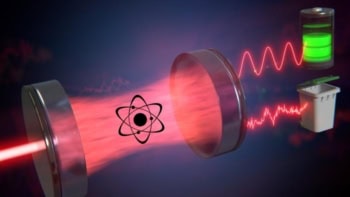
Researchers at Princeton University in the US have made a key step towards realizing scalable quantum networks thanks to a rare-earth element: erbium. Erbium is good at emitting and absorbing photons at wavelengths used in the telecommunications industry, which is an advantage because these photons can travel long distances with little attenuation in standard optical fibres. Harnessing this strength in the quantum realm has been a challenge, but the Princeton team managed to coax an erbium-based device into emitting identical photons – a prerequisite for quantum repeaters to share quantum information across vast distances.
“Erbium-doped fibres are used as classical repeaters to make classical fibre amplifiers for all kinds of optical communications links, like long-haul undersea cables,” says Jeff Thompson, a professor of electrical and computer engineering at Princeton and principal investigator on the work. “So, to me, it was very natural to try to come up with a quantum version of that.”
Advantageous, but tricky to work with
Photons may be natural information carriers, but they are hard to hang on to and rarely interact with each other. This means that if a photon is lost or the information encoded in it degrades, other photons cannot come to the rescue. Instead, quantum information needs to be stored in some kind of memory – in this case, an atom. “A quantum repeater is really just a way of mapping quantum information back and forth between light and atoms,” explains Elizabeth Goldschmidt, a professor of quantum optics at the University of Illinois-Urbana Champaign, US who was not involved in the work.
In repeater-based quantum networks, the idea is to establish entanglement between two distant points by dividing that distance into chunks. The way this works is that a quantum repeater at one end of the long-distance channel emits a photon, and, in the process, becomes entangled with it. Another repeater a short distance down the channel also emits a photon in the direction of the first. When the two photons meet, they are measured in a way that entangles them. As long as the photons remain entangled with their respective emitters, the emitters also become entangled. By continuing this process down the chain, eventually the two emitters at opposite ends of the channel will become entangled. Then they can be used as shared keys in a quantum key distribution scheme, or they can share a bit of quantum information via a quantum teleportation protocol.
Repeat after me
Other quantum repeater technologies have been developed using various atoms or defects in diamond. However, these systems generally emit photons at near-visible frequencies, which attenuate quickly in optical fibres. To function optimally, they require frequency conversion, which is complex and can be expensive. A repeater that automatically emits light of the desired colour would greatly simplify the process.
To make an erbium atom function as such a quantum repeater, two main things need to go right. First, the atom needs to emit photons quickly enough to make the scheme practical. Second, the emitted photon must preserve its quantum properties and stay entangled with the atom that emitted it despite disruptions – a property known as coherence.
Unfortunately, erbium atoms in the wild emit telecom-band photons only very rarely. To boost erbium’s emission rate at the desired colour, the team placed the atom inside a crystal, mere nanometres away from the surface. Atop this crystal, they placed a cavity, which is a silicon nanophotonic device designed to trap light at the precise wavelength erbium emits. By the erbium atom to this cavity, the Princeton researchers persuaded it to emit telecom photons almost 1000 times more frequently than it otherwise would.
Choose wisely
To preserve the photons’ quantum coherence long enough to transmit entanglement, Thompson and colleagues had to choose their crystal material very carefully. From thousands of initial possibilities, they tried around 20 in the lab before settling on calcium tungstate, which brought the emitted photons’ coherence high enough for them to participate in quantum interference with each other. This quantum interference is necessary for the photon-entangling measurement stage in the quantum repeater architecture.

New quantum repeaters could enable a scalable quantum internet
The next step, which the Princeton researchers say is within reach, is to demonstrate entanglement between photons emitted from different erbium atoms. After that, it is a matter of daisy-chaining the repeaters together to form a quantum communication channel. The researchers believe this technology should be easy to scale since it leverages the mature silicon photonics industry. “I think this is a very novel and important thing,” Goldschmidt says. “Rare earth atoms can retain much of the excellent coherence that you get with atoms or ions in vacuum, while being highly engineerable and compatible with device integration, as shown so clearly in this work.”
The research is described in Nature.



